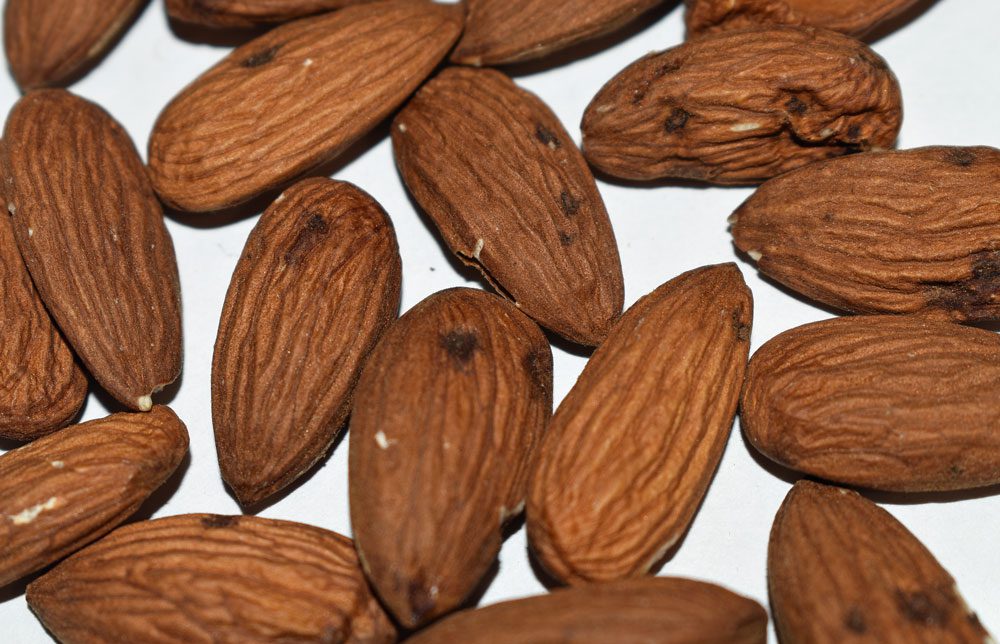As Mel Machado, Blue Diamond Growers’ vice president of member relations, clicks through the data comparing reject levels from 2021 to previous years, he doesn’t like what he sees in the brown spot column.
“What’s got me spooked is not just the total amount of [brown spot] damage, but it’s the trend,” Machado said. “It’s growing as a percentage of damage, and we don’t have a lot of good ways of controlling it. There are no treatment thresholds; it’s just a judgment call.
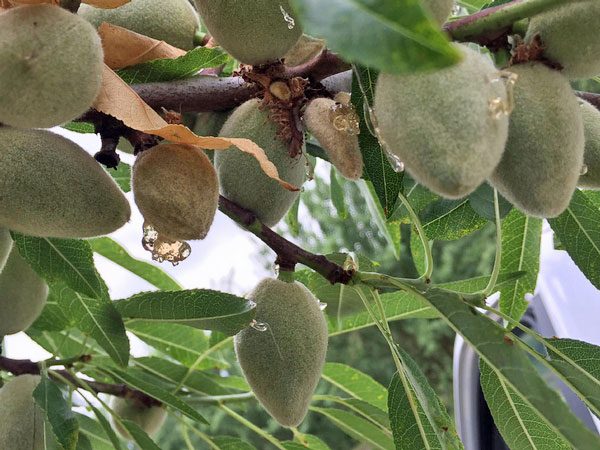
“At this point, what do I know? Not much. We have limited tools to control it, and the trend makes me nervous. The classic tools we use to treat navel orangeworm don’t work in this case. They’re not living in the mummies to overwinter. They’re living somewhere else.”
He was quick to point out that the information was only from a minority of Blue Diamond growers who had requested a reject breakdown of their deliveries. They don’t necessarily mirror the co-op’s overall tonnage, but Machado is not taking the data lightly.
U.S. Department of Agriculture and California Department of Food and Agriculture score brown spot, a sunken area or dimple in the almond kernel greater than 1/8 inch and possibly accompanied by skin stain, as a reject.
What’s Behind Brown Spot?
Machado and other industry experts say they suspect leaf-footed plant bugs (LFB) and/or large stink bugs feeding on the kernel from mid-season until harvest are responsible for the reject.
LFB and stink bugs are known as “true bugs” and belong to the insect order Hemiptera. They insert their stylet into the host (in this case, almonds) to feed. As they do, they inject one or more enzymes with their saliva that liquefy the plant tissue. Then they suck up the liquid.
Early season feeding by LFB and brown marmorated stink bug may result in kernel shriveling, abortion or nut drop, said Jhalendra Rijal, a UCCE integrated pest management expert conducting research in Hemipteran pests in almonds.
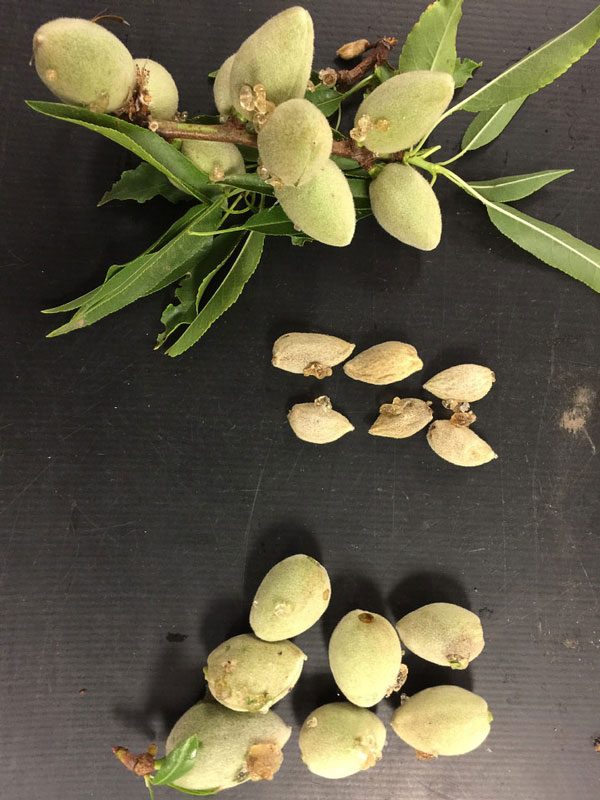
From mid-season on, feeding on the nuts may result in gummy kernel, kernels with brown spots or combinations. In some cases, kernel dimpling occurs. Feeding spots may also provide entryways for yeast or other non-pathogenic fungi, which can colonize the kernel and possibly also cause staining of the kernel skins.
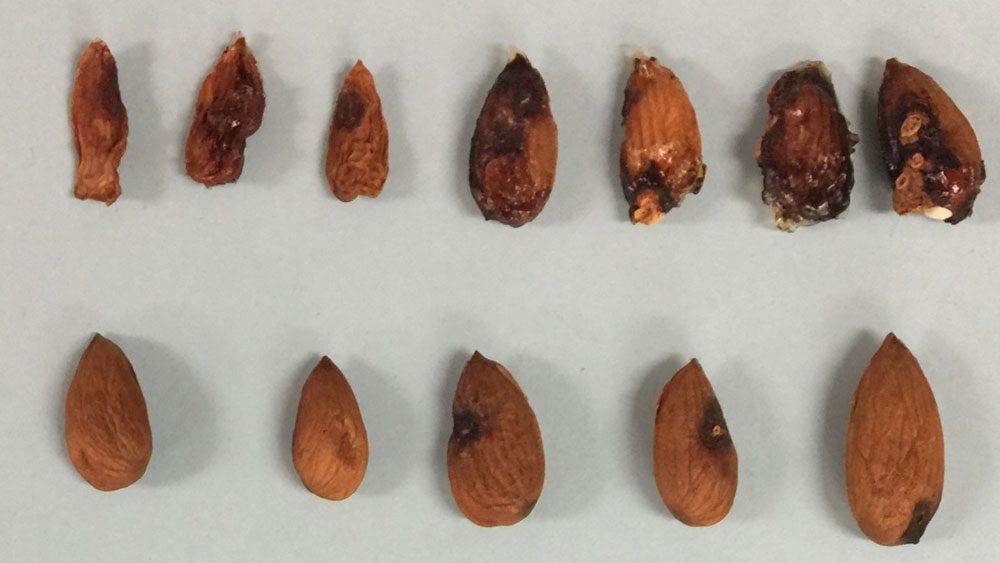
The extent of damage depends on several factors, including the species, population, kernel stage when feeding occurred and host crop, he said.
Leaf-Footed Plant Bugs
California is home to three common leaf-footed plant bugs species, but all cause similar damage. They are large, slender insects (up to one inch long) with long stylets.
Adult LFB overwinter outside of orchards and migrate into them in March or early April, seeking food before they mate. And it’s the feeding on young almonds that can cause significant nut drop, Rijal said.
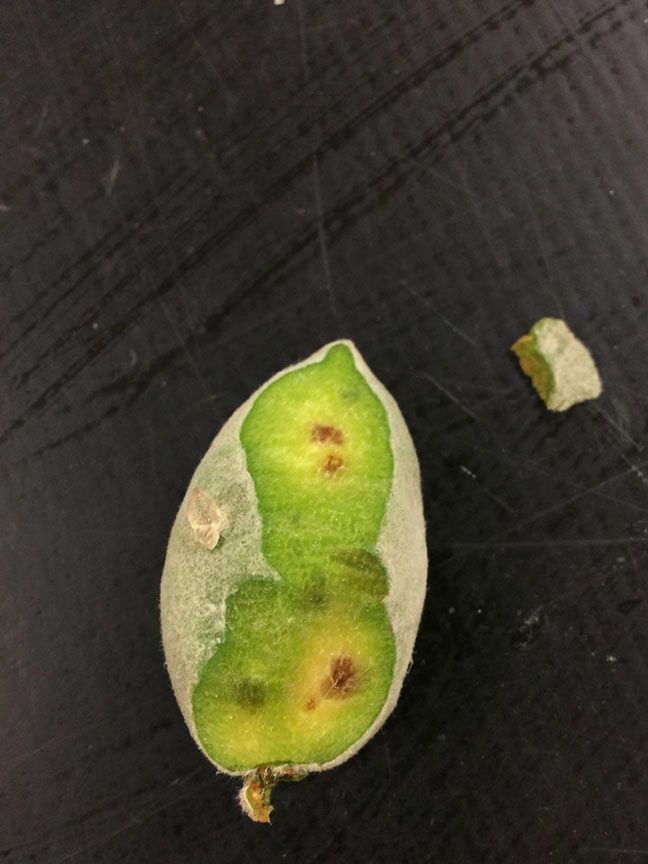
Females then lay eggs. Depending on the temperature, it takes about 60 days for one generation to be completed.
Signs of stink bug feeding and, to a lesser extent, plant bug feeding mid- to late-season include gumming. A clear or sometimes white droplet will ooze from the hull. Other insect as well as physiological problems also may cause gumming, so the symptom isn’t a sure sign of stink bug presence.
Machado said he’s seen nuts with gumming on the hulls, but he finds no kernel damage when he cuts into the nut. The opposite also is true. He’s found kernels with no gumming on the hull exterior but kernel damage.
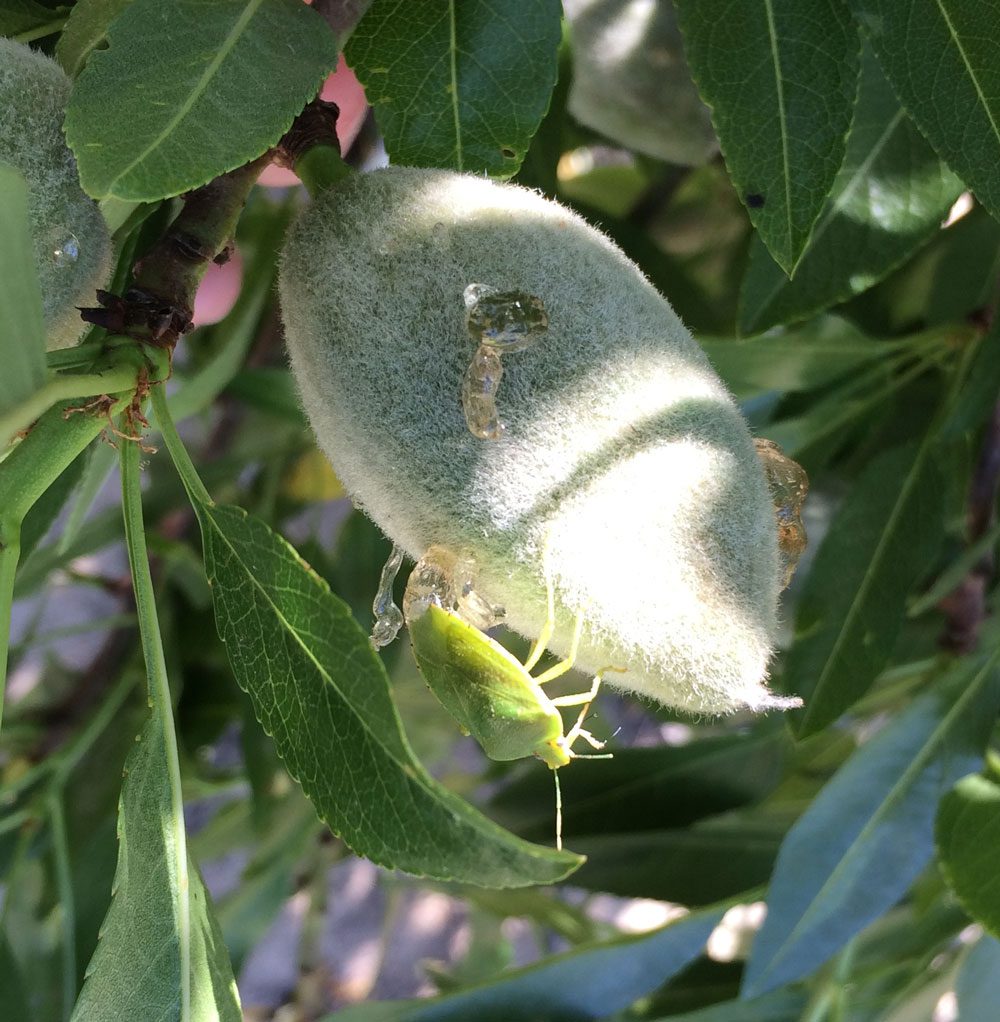
Multi-generations of LFB live in the orchard until fall when aggregation pheromones cause them to gather in large groups. Although LFB may be present in the orchard, their numbers seem to be low, Rijal said. They do not cause significant nut damage, especially after shell-hardening compared to when the overwintered adults first migrate into the orchard. Pomegranates are one of their favorite crops on which to congregate before they move to overwintering sites elsewhere.
With no pheromone traps available, growers and PCAs are left trying to visually scout orchards for the elusive plant bug, which tends to camouflage well. It also runs to the other side of kernels or branches when spotted.
Frequently, PCAs will instead look for feeding signs, although the symptoms are after the fact.
Brown Marmorated Stink Bugs
Brown marmorated stink bug (BMSB) is a relative newcomer to the state, having first been confirmed in urban areas in 2006. Since then, it has expanded to rural areas and has begun to cause damage to almond orchards in the northern and central San Joaquin Valley, Rijal said.
Compared to the native half-inch green stink bug, BMSB is slightly larger at up to 0.75 inches. What sets it apart is aggressive feeding and a host range that spans more than 170 plant species, including numerous crops. Among its preferred host is the ornamental tree-of-heaven.
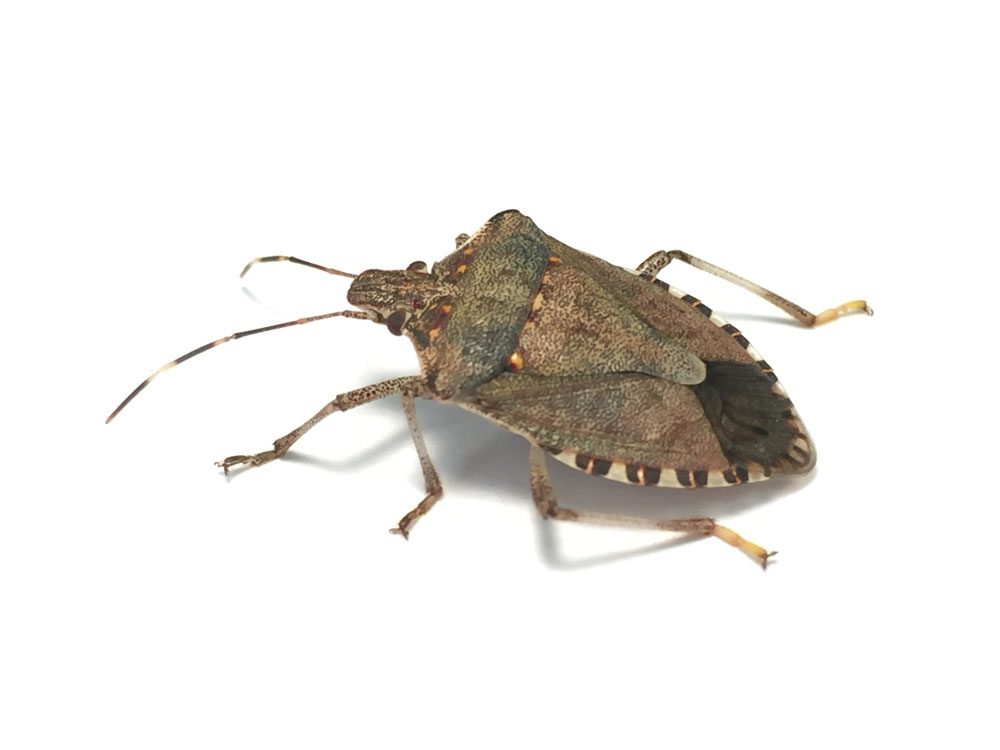
BMSB overwinter under plant litter, in wood piles and other protected areas. As temperatures warm, they become active and migrate into orchards.
Unlike plant bugs that tend to have one migration in the spring, BMSB will continuously move in and out of host crops, Rijal said. Like plant bugs, BMSB also feed throughout the season on almonds. In fact, he said, he has seen the new pest probing nuts with hardened shells in September.
In the fall, BMSB also emit an aggregation pheromone, and they’ll move in masse to protected areas, including houses, to overwinter.
Of the almond-feeding Hemipterans, BMSB is the only one for which traps and lures are available commercially for monitoring. They are effective in detecting BMSB adults and lesser-extent nymphs as well. In many cases, Rijal said, growers and PCAs don’t put them out until they have a problem. Otherwise, they scout for the stink bug itself, egg masses and feeding signs.
Native Stink Bugs
In mid-season beginning about June, a complex of native plant-feeding stink bugs, including green, consperse, Uhler and redshouldered, may join the other Hemiptera in the orchard. In addition, the predatory rough and spine-shouldered stink bugs may be found. Based on orchard surveys conducted in 2021, Rijal said the green stink bug is the most common of the native stink bugs.
“I’ve noticed they’re common in the mid- to late season in almonds in the valley, and higher pest pressure and damage occur in the southern part of the valley where there are other field crops nearby,” he said. “Once the crops are harvested, they move into the orchard. Not all the feeding at that time by these native stink bugs translates into kernel damage, but if there’s enough, it will.”
All the destructive stink bugs may feed on almonds, potentially causing gumming and kernel damage. Trying to figure out what species is responsible is nearly impossible.
“When they feed, they leave some kind of sign in the kernel which is generally expressed as brown spot,” he said.
Stink Bug Control
Winter orchard sanitation, which has long been the foundation of navel orangeworm control, is ineffective against stink bugs because they typically don’t overwinter within orchards. But that doesn’t mean growers should let up on winter sanitation, Machado said.
When growers and PCAs begin to see suspected stink bug-caused nut damage or stink bugs themselves, they’re left in a quandary because there have not been any treatment thresholds developed for these pests, Rijal said.
In addition, only a handful of insecticides, including a few pyrethroids and one to two neonicotinoids, are considered effective for stink bugs, he said. Although pyrethroids may be economical, they’re also broad spectrum and will knock out beneficials like flaring mites. And use of neonicotinoids is discouraged because of its potential toxicity to bees and pollinators.
BMSB also pose control challenges because of their continuous migration patterns, so an insecticide application will only affect those in the orchard at the time.
Shedding Light on Stink Bugs
Rijal hopes to shed more light on true bugs and the associated damage with ongoing orchard surveys and research funded by the Almond Board of California.
“We’re trying to figure out what Hemiptera species are present and what part of the season one insect is more common than the others,” he said.
During 2021, Rijal and other collaborators visually sampled 21 different orchards in San Joaquin Valley as well as used beat trays to determine true bug species composition at different times of the season. BMSB traps were also deployed, and they caught the pest in almond orchards in Fresno County, which is new. They have been finding BMSB and damage in several almond orchards since 2017 in northern San Joaquin Valley counties, and the range has been expanding.
In 2018 and 2019, Rijal conducted caged feeding trials with BMSB that looked at how feeding at specific kernel growth stages correlated to different types of damage.
“We’re trying to see what time of year is more critical, what time of year we can see damage and what are the differences,” Rijal said. “What we found was it was pretty obvious in the early part of the season through the first week of May that they caused significant nut drop. After that into July, when the shell is already hard, they’re still able to feed on it and cause brown spot damage to the kernel.”


